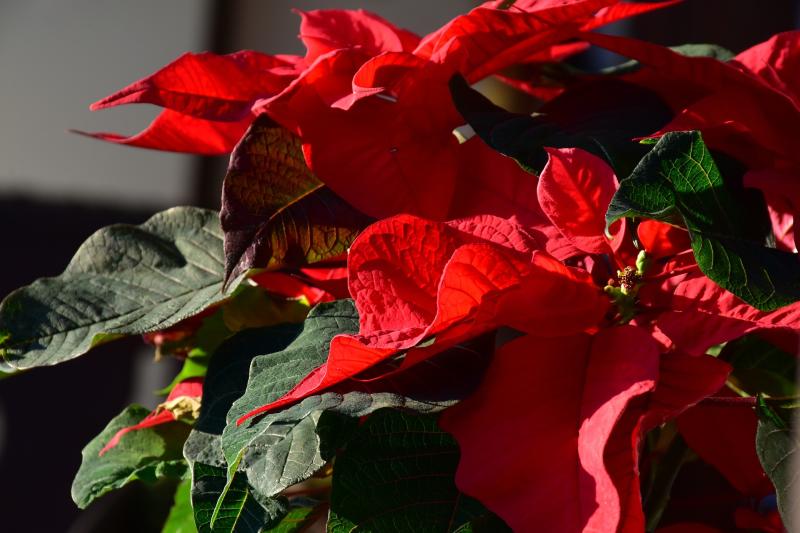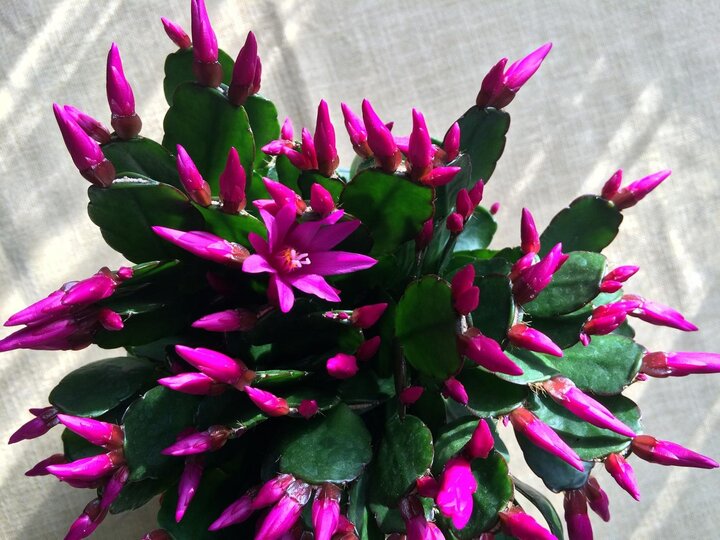Sarah Browning, Nebraska Extension Educator

Poinsettias come in many colors and make a wonderful holiday plant. Image from Pixabay.com.
A holiday plant can be the perfect gift for many occasions, but to ensure a beautiful, healthy plant use care when selecting and transporting your gift.
Selection
When choosing a poinsettia, look for a full, well-branched plant with good color development in the showy bracts and dark green leaves. A fresh poinsettia will have little or no yellow pollen showing on the true flowers, but instead a small cluster of round yellowish buds in the center of the colorful bracts.

Also avoid plants if small white gnats fly up out of foliage when the plant is touched. Or if white gnats are found on the undersides of the leaves. These insects, called whiteflies, are a common greenhouse pest of poinsettia and other holiday plants. Once in your home they will fly and infest many other houseplants. And they are very difficult to control, so don’t bring them into your home.
However, don’t confuse droplets of white milky sap that may be found on poinsettia stems or leaves with whiteflies. Poinsettias are in the Euphoria family and normally have white, milky sap.
Do not choose a plant that is displayed inside a paper or plastic sleeve that reaches above the top foliage. Although the plant should be placed in a sleeve before it's taken home to protect the branches from being broken, plants allowed to remain in the sleeve for a long period of time often experience yellowing and dropping of the lower leaves due to ethylene buildup around the foliage.
. Transporting Plants Home
Holiday plants have been growing in a warm greenhouse before arriving at the store, and they are sensitive to cold temperatures. Poinsettias and other holiday plants can be damaged by temperatures below 50° F.
So whether you buy a plant from a greenhouse or florist, or are giving a plant you’ve grown yourself, make sure it’s wrapped in several layers of paper with some dead air space between the layers before you take the plant outdoors. The final layer might be a heavy grocery sack or cardboard box.
Rush the plant from the shop or greenhouse to your heated car. If your shopping trip includes other stops, make them first, so plants don’t sit in a cold car and get chilled. When it’s time to take plants from the car, again move them quickly.
Care at Home
Keep in mind that most Christmas plants do not tolerate either hot or cold drafts well. They do best with temperatures on the cool side (65 to 75 degrees F during the day and a little lower at night) and plenty of bright light. They will probably be chilled and injured if placed on a cold windowsill, however, especially if drapes or shades are pulled over them at night. A table near a window is better.
Avoid placing them where they'll be hit by blasts of cold air from an exterior door or gusts of hot air from a furnace duct. Heat from a wood stove, fireplace or heat-producing appliance like a television set will also speed their decline.
Once the plants are in place, keep them looking attractive and blooming longer by giving them proper care.
Most flowering plants -- including amaryllis, azalea, begonia, Christmas pepper, chrysanthemum, cyclamen, gloxinia, holiday cacti and poinsettia -- bloom best in a spot that receives all the natural light available. Better yet is 12 to 16 hours of bright light from fluorescent tubes.
Check plants daily and water whenever the soil surface begins to feel dry. If containers have drainage holes in the bottom, add water until some drains out the bottom. Plants in containers without drainage holes are very easy to overwater. Plant roots need air as well as water -- too much water and they die and then rot.
Compared to the greenhouses where the plants were grown, most houses are extremely dry, and plants may suffer from low humidity. Leaves may dry around the edges and flower buds fail to open or fall prematurely. Grouping plants on trays of moist gravel, placing them in areas of the house that are naturally more humid, such as the kitchen or bathroom, or using a room humidifier to add moisture to the air should help prolong flowering. Keeping plants out of warm drafts and away from TVs and other appliances that give off heat will also help.
High temperatures will shorten the flowering period, as well as increase problems due to low humidity so place plants where they'll be exposed to temperatures of 65 to 75 degrees F during the daytime and 50 to 55 degrees at night. Cyclamen and paperwhite narcissus will hold up better at 60 to 65 degrees during the day and 50 degrees at night.
Fertilizing usually isn't necessary unless the plants are going to be kept and rebloomed and this is usually practical only with amaryllis and holiday cacti. Other flowering plants require temperature and/or light conditions that are difficult to achieve in the home.
Gift Instructions
Any plant going from a brightly lighted greenhouse or shop into the dry, low-light environment of a typical home in later December will have some adjustments to make. Be sure to give the giftee some care instructions along with the plant so they can care for it properly to keep it healthy.
Images from Pixabay.com.
- Christmas or Thanksgiving cactus are an easy houseplant to grow and provide beautiful color during the winter months.
- Ornamental peppers are pretty and colorful, and they are edible, too! But watch out, they can be very hot!
Search Our Archive
Associated Video
Holiday Plant Care
Nebraska Extension Educator Terri James talks about holiday plant selections and how to care for them.